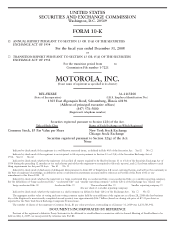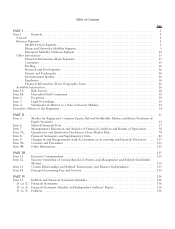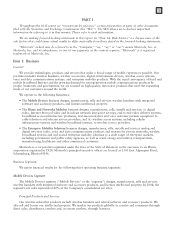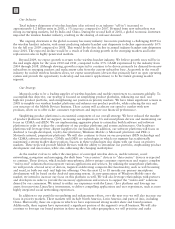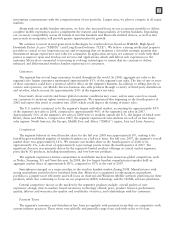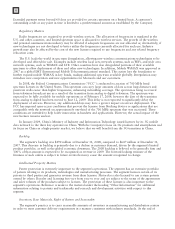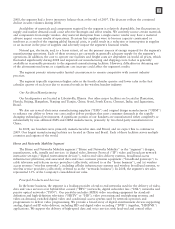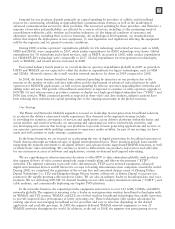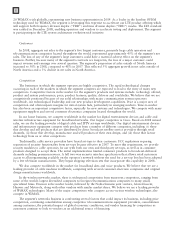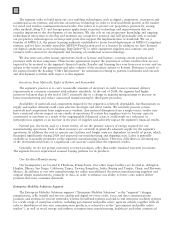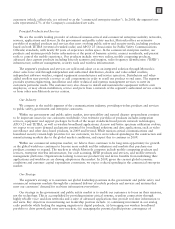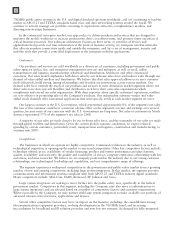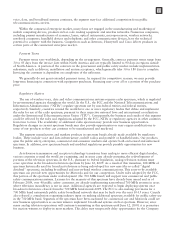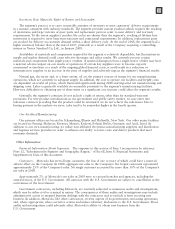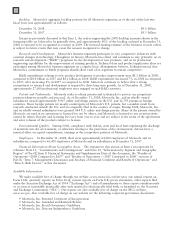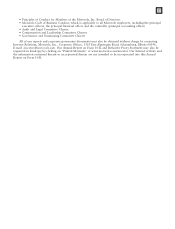Motorola 2008 Annual Report Download - page 16
Download and view the complete annual report
Please find page 16 of the 2008 Motorola annual report below. You can navigate through the pages in the report by either clicking on the pages listed below, or by using the keyword search tool below to find specific information within the annual report.
20 WiMAX trials globally, representing new business opportunities in 2009. As a leader in the baseline OFDM
technology used for WiMAX, the segment is leveraging this expertise to accelerate our LTE product offering which
will support both frequency division duplex (“FDD”) and time division duplex (“TDD”) modes. The LTE standard
was ratified in December 2008, enabling operators and vendors to accelerate testing and deployment. The segment
is participating in the LTE system architecture evolution trial initiative.
Customers
In 2008, aggregate net sales to the segment’s five largest customers, primarily large cable operators and
telecommunication companies located throughout the world, represented approximately 45% of the segment’s net
sales. The loss of any of the segment’s large customers could have a material adverse effect on the segment’s
business. Further, because many of the segment’s contracts are long-term, the loss of a major customer could
impact revenue and earnings over several quarters. The segment’s proportion of sales outside of North America
increased to 50% in 2008, compared to 48% in 2007. This reflected 5% aggregate growth in net sales outside of
North America and a 3% decline in net sales in North America.
Competition
The businesses in which the segment operates are highly competitive. The rapid technological changes
occurring in each of the markets in which the segment competes are expected to lead to the entry of many new
competitors. Competitive factors in the market for the segment’s products and systems include: technology offered;
product and system performance; price; product features; quality; delivery and availability. We believe that we are
competitively positioned because of our solid relationships with major communication system operators
worldwide, our technological leadership and our new product development capabilities. Price is a major area of
competition and often impacts margins for initial system bids, particularly in emerging markets. Time-to-market
has also been an important competitive factor, especially for new systems and technologies. We compete with many
equipment suppliers and several consumer electronics companies located throughout the world.
In our home business, we compete worldwide in the market for digital entertainment devices and cable and
wireline infrastructure equipment for broadband networks. Our largest competitor is Cisco. Based on 2008 annual
sales, we are the leading provider of digital cable and IPTV set-tops worldwide. Our digital entertainment devices
and infrastructure equipment compete with products from a number of different companies, including: (i) those
that develop and sell products that are distributed by direct broadcast satellite service providers through retail
channels, (ii) those that develop, manufacture and sell products of their own design, and (iii) those that license
technology from us or other competitors.
Traditionally, cable service providers have leased set-tops to their customers. FCC regulations requiring
separation of security functionality from set-tops became effective in 2007. To meet this requirement, we provide
security modules to cable operators for use with both our own and third-party set-tops, as well as in consumer
products designed to accept them. The initial implementation limited consumer products to broadcast-delivered
channels including premium services. A full two-way security interface specification that allows retail customers
access to all programming available on the operator’s network without the need for a set-top box has been adopted
by a few television manufacturers. They began shipping television sets that incorporate this capability in 2008.
We also compete worldwide in the market for broadband data and voice products. We believe that we are a
leading provider of cable modems worldwide, competing with several consumer electronic companies and original
design manufacturers worldwide.
In the wireless networks market, there is widespread competition from numerous competitors, ranging from
some of the world’s largest diversified companies to foreign telecommunications companies to many small,
specialized firms. Ericsson is the market leader, followed by the Nokia-Siemens joint venture, Alcatel-Lucent,
Huawei and Motorola, along with other vendors with similar market share. We believe we are a leading provider
of WiMAX technologies. Many of the major competitors who compete across various wireless technologies also
compete in WiMAX.
The segment’s networks business is confronting several factors that could impact its business, including price
competition, continuing consolidation among competitor telecommunications equipment providers, consolidation
among customers, the potential impact of global economic conditions, and vendor financing by competitors as
customers continue to look to vendors as an additional source of financing.
8



